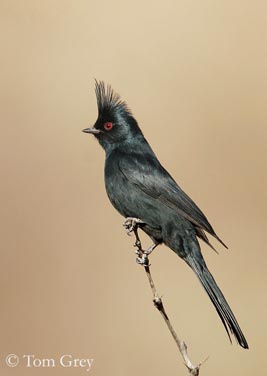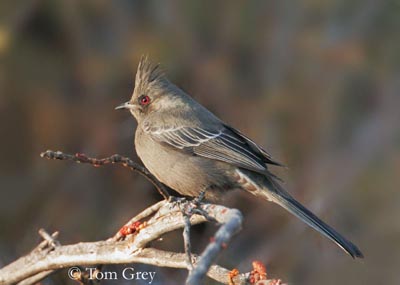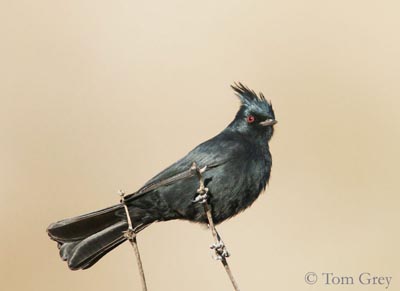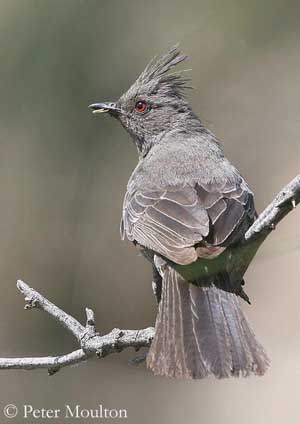
Phainopepla
Phainopepla nitens
Passeriforme Order - Ptiliogonatidae Family
BIOMETRICS :
Length: 18-21 cm ; Wingspan: 29 cm ; Weight: 18-28 g
DESCRIPTION:
Phainopepla is an elegant bird with soft black plumage, very agile in flight. It is part of the tropical silky flycatcher group.

Phainopepla adult male has entirely glossy black plumage, except on wings where the inner webs of primaries are white with black tips. Very conspicuous in flight, they form a white wing patch. Black tail is long and rounded.
We can see a prominent erectile crest on top of head. Blackish bill is thin and short. Eyes are red. Legs and feet are black.

Adult female is greyish, and she has pale grey wing patch.
Immature resembles female but it is browner, with brownish eyes. Immature male has varying plumage, from mixed grey and black, to entirely black.
VOICE: SOUNDS BY XENO-CANTO
Phainopepla’s common call is a low-pitched, whistled “wurp”. This call is often accompanied by flicking tail and turning from side to side. Both sexes give harsh “churr” during aggressive behaviours.
Phainopepla’s song is a whistled “wheedle-ah” multi-syllabic. It also utters variable series of quiet sounds. Both sexes give soft and brief vocalizations at nest. During courtship, female may utter soft “churr” prolonged. Alarm and distress calls are loud, scream calls.
Phainopepla may also imitate other call’s species, and mimicries may distract predators. It is able to reproduce about 12 to 13 different calls of other species. Both sexes click bill rapidly, producing snapping sounds, mainly during nest construction.
HABITAT:
Phainopepla breeds in early spring in mesquite brush land, but in late spring, it moves into cooler and wetter habitat for raising a second brood.
Winter and early spring are spent in desert. During summer, it is found in woodland and chaparral.
RANGE:
Phainopepla breeds in central California, southern Nevada, Utah, New Mexico, and western Texas, southwards to Baja California and into Mexico.
It winters in southern California and Nevada, central Arizona, southern New Mexico and Texas.
BEHAVIOUR:
Phainopepla is fond of mistletoe berries found in desert areas. It has specialized digestive apparatus to process great numbers of these berries, by rapidly removing skin of fruit. Pulp of mistletoe berry is sticky and Phainopepla may consume about 1,000 berries per day. It is the more effective dispersal agent for desert mistletoes, with the seeds included in its droppings.
Phainopepla forages in shrubs and swallows berries whole. It also catches flying insects, performing sallies from branches. This bird can hover and flutter in the air, and then turn abruptly when pursuing insects. It is rarely seen on ground, except when collecting nest material.

Phainopepla chases intruders away from territory. It often utters harsh “chuur” at this moment. Feeding areas and nest-sites are defended in desert, but not in woodlands, according to the spatial separation of fruit from nest area.
Separate territories are established by male and female in October, and these areas are defended through winter. During breeding season, one bird abandons its own territory and joins that of its mate. Territorial birds perch on top of large scrubs or trees, and call. During summer, small territory including single tree and marginal area are not defended. Birds may form loose colonies of 3 to 15 pairs, and they may move together when breeding season ends.
Courtship displays are initiated in late January, with courtship flights. Birds fly in loose, circling flock at about 25 to 100 metres above the ground. This fly is initiated by a single male.
We can observe courtship assemblage. Male builds most of the nest, and female add portion of cup lining. Nest displays are also performed, with male flying close to the nest, from above to down, displaying its white wing patches. Male performs courtship feeding, offering insects or berries to begging female. Copulations occur on exposed branches. Phainopeplas are monogamous.
In response to predator, Phainopepla mobs as well birds as snakes and mammals. They vocalize and click bills during mobbing.
Phainopepla is short distance migrant, moving from Sonora Desert to semi-arid woodlands in surrounding areas. Only northern birds migrate.
FLIGHT:
Phainopepla performs buoyant flight, often making zigzags when pursuing preys. It also has direct and fluttering flight.
REPRODUCTION:
Phainopepla’s nest-site is selected by male, but female may choose between several nests. Nest is often placed at 2 to 5 metres above the ground, in a fork of branch, or in a clump of mistletoe in mesquite, acacia, oak or sycamore.
Male builds the nest during courtship displays, and female aids completion. Assemblage displays shows both sexes shaping nest by sitting in it, clicking bill when partner gathers nest material, or are just arriving. They utter “kuk-kuk” when take turns at nest.
Open cup-shaped nest is made with stems, twigs, caterpillar and spider silk and plant fibres. Lining is made with hair or down. It is very well shaded by vegetation.

Female lays 2 to 4 slightly glossy greyish or greenish eggs, speckled with dark markings. Incubation lasts about two weeks, shared by both parents. Altricial chicks are brooded and fed mainly by female.
Young fledge about 20 days after hatching, but they may leave the nest at 14 to 19 days, remaining through vegetation and then, return to nest for food. Young and parents stay in family groups for at least one week.
This species produces two broods per season.
DIET:
Phainopepla feeds mainly on berries, particularly mistletoe berries (Phoradendron californicum). They also consume flying insects.
Phainopepla’s excrements often form mounds on twigs, beneath territorial perches. Seeds included in their droppings spread mistletoes in other areas, but also in trees which are parasitized by this plant species.
PROTECTION / THREATS / STATUS:
Agricultural development may cause some declines in Phainopepla populations. Mesquites are cleared, and this species looses parts of its range. Freezing weather in Sonora Desert may destroy main Phainopepla’s food resources, and reduce populations for several years.
However, populations seem to be stable and not listed as threatened or endangered.
Fr: Phénopèple luisant
All : Trauerseidenschnäpper
Esp : Papamoscas Sedoso
Ital : Fainopepla nera
Nd : Zwarte Zijdevliegenvanger
Russe : Черный шелковистый свиристель
Sd : Svart silkesflugsnappare
Photographs by Tom Grey
Tom Grey's Bird Pictures
Photographs by Pete Moulton
Pete Moulton Photography
Text by Nicole Bouglouan
Sources :
FIELD GUIDE TO THE BIRDS OF NORTH AMERICA - National Geographic Society - ISBN: 0792274512
All About Birds (Cornell Lab of Ornithology)
Animal Diversity Web (University of Michigan Museum of Zoology)
What Bird-The ultimate Bird Guide (Mitchell Waite)
Wikipedia (Wikipedia, The Free Encyclopedia)